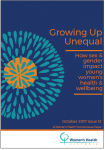The aim of this paper is to look at young women's health and wellbeing between the ages of 10 and 20. We examine young women's experience of six interrelated priority health areas: physical health, sexual and reproductive health, body image, relationships, mental health and social inclusion.
This infographic summarises in pictorial form key messages relating to young women's health and wellbeing.
This infographic summarises in pictorial form some key features relating to the future of young women's health and wellbeing.
This fact sheet summarises the key points relating to young women and physical health, sexual and reproductive health, body images, relationships, mental health and social inclusion.
Sport and increased physical activity has potential to make a huge difference in the lives and wellbeing of women and girls in Victoria.
This Connector contains a selection of freely available resources focusing on young women's health.
This Clearinghouse Connector contains a selection of up-to-date freely available resources on long acting reversible contraceptives (LARC). These are methods of contraception that require administration less than once per month, and can be removed or 'reversed', and should not affect long-term fertility.






